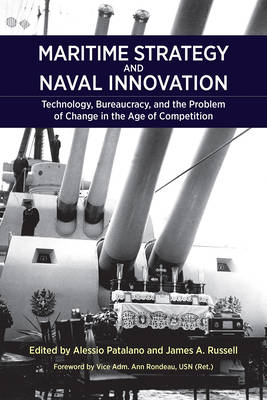
- Afhalen na 1 uur in een winkel met voorraad
- Gratis thuislevering in België vanaf € 30
- Ruim aanbod met 7 miljoen producten
- Afhalen na 1 uur in een winkel met voorraad
- Gratis thuislevering in België vanaf € 30
- Ruim aanbod met 7 miljoen producten
Zoeken
Maritime Strategy and Naval Innovation
Technology, Bureaucracy, and the Problem of Change in the Age of Competition
Alessio Patalano, James Russell
Paperback | Engels
€ 122,45
+ 244 punten
Omschrijving
The essays in this book highlight the connective tissue between maritime strategy and naval innovation. The cases and perspectives in this collection of essays by some of today's foremost strategic thinkers are both retrospective and prospective and carry on an intellectual tradition established by the likes of Alfred Thayer Mahan. Composed of four parts, each one deals with a specific aspect of strategic innovation, beginning with an investigation of the context of maritime strategy, focusing on how international security relates to its requirements. The second section focuses on the role of organizational and bureaucratic factors in naval innovation, engaging with the issues of balancing operational stability against future requirements. The third section builds upon the previous two to more closely address the impact of new tactics and technologies on war at sea, exploring the impacts of technological change against a backdrop of broader strategic and security concerns. Finally, the fourth section segment of the book makes an original contribution to the naval innovation debate. Here, the authors widen the organizational change agenda, and discuss the extent to which real naval innovation in an interconnected world should also mean engaging with the challenges of operating with partners.
Specificaties
Betrokkenen
- Auteur(s):
- Uitgeverij:
Inhoud
- Aantal bladzijden:
- 320
- Taal:
- Engels
Eigenschappen
- Productcode (EAN):
- 9781682475256
- Verschijningsdatum:
- 31/01/2021
- Uitvoering:
- Paperback
- Formaat:
- Trade paperback (VS)
- Afmetingen:
- 152 mm x 224 mm
- Gewicht:
- 430 g

Alleen bij Standaard Boekhandel
+ 244 punten op je klantenkaart van Standaard Boekhandel
Beoordelingen
We publiceren alleen reviews die voldoen aan de voorwaarden voor reviews. Bekijk onze voorwaarden voor reviews.











